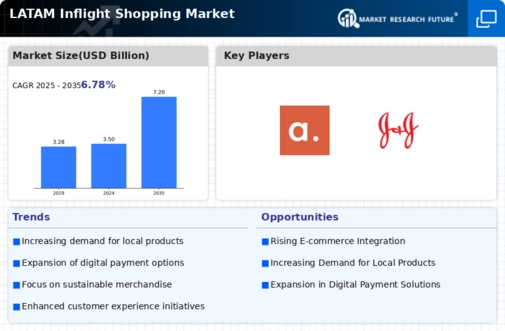Latam Inflight Shopping Size
LATAM Inflight Shopping Market Growth Projections and Opportunities
The LATAM inflight shopping market is influenced by several key factors that shape its dynamics and growth opportunities. Firstly, the overall air travel industry in Latin America plays a significant role in determining the demand for inflight shopping. Factors such as economic stability, disposable income levels, and tourism trends affect passenger traffic and, consequently, the potential customer base for inflight retail.
Secondly, the growth of the middle class in Latin America has been a driving force behind the expansion of inflight shopping. As more people in the region have higher disposable incomes, they are increasingly inclined to spend on luxury items and souvenirs during their travels. Airlines and retailers capitalize on this trend by offering a wide range of products tailored to the preferences of the middle-class traveler.
Thirdly, technological advancements and changes in consumer behavior impact the inflight shopping market. The rise of e-commerce and mobile shopping has transformed how passengers browse and purchase products onboard. Airlines are investing in inflight Wi-Fi and onboard entertainment systems that enable passengers to shop conveniently from their smartphones or tablets, expanding the reach of inflight retail.
Moreover, airline partnerships and collaborations with retailers and brands play a crucial role in shaping the LATAM inflight shopping market. Airlines often form strategic alliances with renowned brands and duty-free operators to offer exclusive products and promotions onboard. These partnerships enhance the attractiveness of inflight shopping and contribute to revenue generation for both airlines and retailers.
Government regulations and policies also influence the inflight shopping market in Latin America. Customs regulations, duty-free allowances, and import tariffs impact the availability and pricing of products onboard. Airlines must navigate these regulatory frameworks to ensure compliance and optimize their inflight retail offerings to maximize profitability.
Additionally, market competition among airlines and duty-free operators drives innovation and differentiation in inflight shopping. Airlines strive to enhance the passenger experience by offering unique and diverse product selections, personalized shopping experiences, and competitive pricing. This competitive landscape fosters creativity and collaboration within the industry, benefiting both passengers and stakeholders.
Furthermore, macroeconomic factors such as currency fluctuations and inflation rates can affect the affordability and purchasing power of passengers, influencing their spending behavior onboard. Airlines and retailers must adapt their pricing strategies and product offerings accordingly to remain competitive in fluctuating economic conditions.
Consumer preferences and cultural trends also shape the LATAM inflight shopping market. Latin American passengers have diverse tastes and preferences influenced by factors such as local traditions, fashion trends, and lifestyle choices. Airlines tailor their inflight retail offerings to cater to these preferences, ensuring a relevant and appealing shopping experience for passengers.
Lastly, the impact of the COVID-19 pandemic on the travel industry has significantly affected the inflight shopping market in Latin America. Travel restrictions, reduced passenger traffic, and changes in consumer behavior have led to a decline in onboard retail sales. However, as travel gradually resumes and passenger confidence improves, there are opportunities for recovery and growth in the inflight shopping market, driven by pent-up demand and evolving consumer preferences.






Leave a Comment